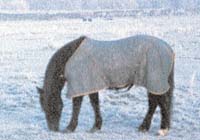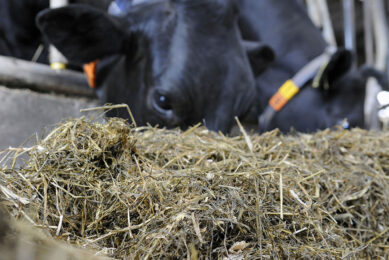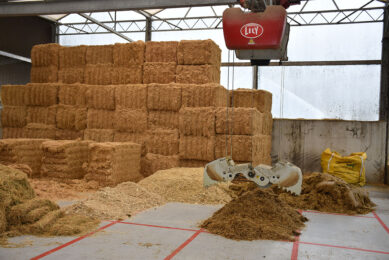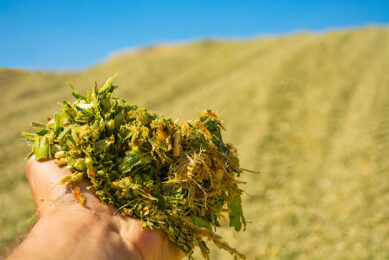Conserved grass takes the load off hay diets for ponies

Hay is not always the best alternative for horses, particularly due to its expense and dust content. Recent research published in the Animal Science Journal shows that silage and haylage can be equally effective for equines, and does not have all the detrimental effects to health that were believed in the past.
By M.J.S. Moore-Colyer and A.C. Longland
| Good quality hay is often scarce and expensive, and high levels of cereals may lead to colic |
Grass hay is the traditional conserved forage offered to horses in the UK, yet good quality hay is often scarce and expensive. Working or breeding horses frequently requires a higher plane of nutrition than that provided by hay, which has a typical digestible energy (DE) value for horses of 8MJ/kg dry matter (DM) (McClean et al., 1995). In order to meet the higher energy demands of these animals, high levels of cereal-based concentrates are offered, which can lead to a number of metabolic disorders such as colic (Jackson, 1998) and laminitis (Eustace, 1995). Furthermore, even good quality hay contains a high level of dust (fungal spores, plant fragments, mites and bacteria) (Woods et al. 1993), which can elicit the onset of the debilitating disorder, chronic obstructive pulmonary disease (COPD) (Clarke, 1992). Horses that have COPD remain sensitised to such dust for the rest of their lives and cannot be given hay without developing the disease (Lawson et al., 1979). Currently, the most popular lowdust alternative to hay is commercially produced haylage, which is grass conserved under anaerobic conditions at a DM of 550 g/kg. However, this haylage is expensive and thus there is increasing interest in feeding cheaper, alternative fibrous forage (fibre = non-starch polysaccharides; NSP + lignin), which have both an enhanced nutritive value and a low dust content.
Which silage to choose?
Clamp silage and big-bale silage are fibrous forages that are conserved at an earlier stage of growth than hay and as a consequence they have a higher nutritive value, with typical metabolisable energy values for ruminants of 12 to 14 MJ/kg DM (MAFF, 1992). These forages form the basis of winter rations for many farm ruminants, but they are seldom given to horses. Clamp silage is considered to have too low a pH and too high moisture content to be either palatable or practical to feed to horses (Pillner, 1992). Furthermore, although conserved in a similar manner to haylage, big-bale silage may occasionally contain Clostridium botulinum and/or Listeria spp., to which horses are particularly susceptible (Gudmunsson, 1997) and this has made some people wary of feeding big-bale silage to their horses. However, anecdotal evidence suggests that increasing numbers of owners are feeding grass silage to horses with no detrimental effects. These silages contain an additional 4 to 6 MJ/kg DM (MAFF, 1992) compared with hay, which enables productivity to be maintained with a reduced reliance on feeding supplementary concentrates.
The aims of this study were three-fold:
a) to determine the intake and digestibility of conserved fibrous forage for ponies;
b) to ascertain if grass silage is a suitable replacement for hay in equine rations;
c) to measure the contribution of the carbohydrate fraction of fibre, the non-starch polysaccharides (NSP) and the DE of the forage.
Four mature Welsh cross pony geldings (LW ca.320 to 370 kg) were used in a 4 x 4 Latinsquare change-over design experiment, consisting of four 21-day periods. Water was available ad libitum. One of each of the four forages, hay (H), haylage (HY), big-bale silage (BB) or clamp silage (CS) were offered at 1.65 kg DM per 100kg liveweight (LW) per day. The diets were offered in two equal meals per day, at 08:00 and 20:00h. Each 21-day period consisted of a 16-day adaptation phase and a 5-day collection phase. Pony LW was recorded at the same time on the last day of each collection period, thus four LW values were recorded for each pony, hence being a reflection of LW after consuming each diet for a three week period.
Nutritive value of forages
During the 5-day collection phase in vivo apparent digestibility (AD) of dry matter (DMD), organic matter (OMD), crude protein (CPD), gross energy (GED) along with total and individual and individual non-starch polysaccharide (NSPD) constituents were determined by total faecal collection. The average chemical compositions of the four experimental forages are given in Table 1. The DM content of the forages was inversely proportional to the crude protein contents and reflected a three-fold range of these nutrients between hay and clamp silage. Gross energy levels were similar across the four forages, whereas mineral levels were variable with hay containing less Ca, P and Mg than the other three forages.
All of the forages contained low levels of rhamnose, mannose and galactose. The uronic acid and arabinose fractions together constituted ca. 0.095 + to 0.14 of the total NSP content of the four foods, whereas glucose and xylose together accounted for more than 0.85 of TNSP.
Liveweight and feed intake
Table 2 shows the average LW and voluntary feed intakes (VFI) of the ponies when offered the four forages at 1.65kg DM per 100kg LW per day. Average pony LW, which was a mean of the LW attained by the four ponies after consuming each diet for 3 weeks, was significantly lower on the clamp silage diet compared with when they were offered either the big-bale or haylage diets, respectively. No significant difference in LW was recorded when the ponies were offered hay, haylage or big-bale silage.
The DMI of clamp silage (kg/d) when expressed per unit LW (g/kg LW/d) or on a metabolic live weight (g/kg M0.75 per day) basis was significantly lower than the intakes recorded for the other three foods. The intake (kg/d) of hay (on a fresh-weight basis) was significantly lower than that of the other three forages. However, when intake was expressed on a DM basis (g/kg LW per day), intake of hay was only significantly lower than that of haylage.
Apparent digestibility
The in vivo apparent digestibility of DM, OM, CP, starch, GE, Ca, P and Mg are shown in Table 3. With the exception of starch, hay was significantly less digestible than the other three forages for all parameters measured. Although the digestibility of haylage constituents were generally 173 to 587 g/kg DM greater than the corresponding values for hay, digestibility values for haylage were still significantly lower than those recorded for clamp silage for CPD and GED. Across all organic measurements, the digestibility of clamp silage and big-bale silage were similar with values in excess of 550 g/kg DM. The digestibility of minerals from hay was significantly lower than from the other three foods. By contrast, with the exception of Ca, the mineral digestibilities from haylage, bigbale silage and clamp silage were similar.
The apparent digestibility of Ca was significantly lower from clamp silage than from haylage or big-bale silage. The apparent digestibilities of NSP and constituent monomers are also shown in Table 3, and indicate that apparent digestibility of total NSP, glucose and xylose of clamp silage and big-bale silage were significantly higher by ca. 200 to 300 g/kg DM than from either the hay or the haylage. Except for rhamnose, the apparent digestibility of all NSP monomers measured in big bale silage and clamp silage were greater than 640 g/kg DM and most of these were digested to a significantly greater extent than in haylage and hay.
The DE content of hay (Table 4) was significantly lower than those of the other three forages. Furthermore, the DE of haylage was significantly lower than that of clamp silage. Digestible CP contents were significantly different between all foods with CS>BB>HY>H.
Silage for energy and protein requirements
Average daily DE intakes of hay and clamp silage were significantly lower than those of both haylage and big bale silage, whether expressed on a pony LW or M0.75 basis. As a result of the slightly lower LW recorded for ponies consuming the clamp silage, the calculated DE requirement was similar to that for hay but slightly lowered than those calculated for the big-bale and haylage diets. The daily DE intakes of big-bale, clamp silage and haylage met or exceeded the calculated daily energy requirement of the ponies, but that of hay did not.
The digestible CP intake for hay was only 34 g/d and provided proportionately only 0.20 of the theoretical daily digestible CP requirements, whereas the digestible CP intakes of the other three forages exceeded this requirement.
The DE content of the individual NSP monomers is shown in Table 5. There was comparatively little variation (range 2.32 MJ/kg DM) in DE contents of the individual monomers in the clamp silage, with much higher variation (range 12.44 MJ/kg DM) noted between monomers for haylage. The DE contents of total NSP constituents varied between diets, with xylose and glucose being considerably higher in big-bale and clamp silage than in haylage and hay.
Table 5 also shows the average energy derived from each NSP monomer per day expressed as the proportional contribution each sugar made to daily DE intake. The degradation of total NSP from hay and bigbale made a significantly greater contribution to dietary DE than that from haylage or clamp silage. The contribution of total NSP from clamp silage to overall DE was significantly lower than the corresponding values for hay and big-bale silage but significantly higher than for haylage. The contribution of NSP glucose to the DE intake of hay, big-bale and clamp silage averaged ca. 0.27 and was significantly greater than the corresponding value of 0.18 for haylage. The remaining NSP constituents individually contributed a maximum of 0.12 to DE intake with xylose contributing more than arabinose≥uronic acids>galactose>mannose.
Silage an acceptable forage
The amount of feed offered was designed to meet the maintenance requirements of the ponies, having been pre-determined in a preliminary experiment in which LW and fed refusals were recorded. However, over the 12-week experimental period, feed intakes varied between ponies and diet, with some ponies showing marked preferences for certain feeds, clamp silage being the least favoured. The preference for the big-bale silage and haylage is reflected in the LW figures, which show a significant increase in LW when ponies were consuming these two diets in comparison with clamp silage. Fresh weight intakes were similar for the haylage, big-bale and clamp silage diets, although the ponies did consume 2.93 kg/day more big-bale than clampsilage, indicating the gut capacity was not a limiting factor in controlling the intake of clamp-silage.
In the current study, the DMI of clamp silage was significantly lower than from the other three forages and may suggest that the DMI of clamp grass silage by horses is generally lower than that of most hays. Indeed, the nutrient profile and fermentation characteristics of silage can affect feed intake and evidence exists which indicates that low intakes by ruminants are associated with high organic acids and it is possible that similar parameters affect DMI in horses. Although the DMI of clamp silage was low, the calculated daily energy requirement (NRC, 1989) was met due to its DE being twice that of hay. However, as the DEI by the ponies given haylage and big-bale silage were 1.66 and 1.7-fold their calculated DE requirements, it is clear that meeting the daily DE requirements per se did not limit DMI in this experiment.
Apparent digestibility values
The apparent digestibilities of DM, OM, CP and GE for H were significantly lower than the values recorded for the other three foods NSP analysis allows a detailed examination of the potentially energy-yielding fraction of fibre, the cell wall carbohydrates. Xylose and glucose were approximately 0.7 digested from big-bale and clamp silage but only 0.4 digested from hay. The clamp silage and big-bale silage were conserved at an earlier stage of growth than the hay and as the fibre fraction of forages is known to increase with increasing plant maturity (Reid, 1997), these increases in plant physiological development may account for the differences observed here. Alternatively, the level of microbial fermentation in the bigbale and clamp silages may have increased the digestibility of the cell wall fraction, partially accounting for the higher apparent digestibility of total NSP of these two forages.
The higher DMI of haylage and big-bale silage, coupled with their gross energy digestibility coefficients, resulted in higher DE requirements of these two feeds compared with clamp silage and hay. The calculated DE requirements of the ponies resulted in higher theoretical DE requirements when ponies were consuming the haylage and big-bale silage diets. These values do not necessarily reflect the DE requirements for the maintenance of optimum LW and when animals are given feed on a LW basis, could erroneously encourage the horse owner to offer more food as LW steadily increases, thereby compounding weight increase in an over-fat animal.
Approximately half of the DE from hay and big-bale silage was derived from the total NSP fraction, (largely from glucose and xylose) whereas only a third and a quarter of the DE originated from this fraction in clamp silage and haylage respectively. The remainder of the DE would have been derived from water-soluble carbohydrates, oil, protein, starch and the products of microbial fermentation occurring during conservation.
The DE contents of any given NSP monomer varied between forages, with the biggest variation being ca. 8 MJ/kg DM for xylose between clamp silage and hay. Prediction equations for estimating the energy value of low fibre feedstuffs for farm livestock, based on chemical composition, are often sufficiently accurate for practical use. However, when similar equations are used with high-fibre feedstuffs, the accuracy of the prediction is frequently compromised (Batterham, 1990). The variation in DE contents of the fibre components in the diets used here serves to illustrate this point, where both the glucose and xylose contents of big bale silage and haylage were similar, but their DE contents were substantially different.
A silage for all occasions
The results from this experiment indicate that clamp silage, big bale silage and haylage were readily digested by ponies and can be used as dust-free forages to replace hay in diets for equids. The DE contents of these three forages were similar to those encountered in many commercially available compound feeds and make these ideal forages for performance horses with high energy demands. However, for the less active horse, intakes of big bale silage and haylage may have to be limited to prevent obesity, whereas regulation of voluntary feed intake of clamp silage is probably unnecessary, as in this experiment DMI was self-limiting. The low DMI noted for clamp silage however requires further investigation. The measurement of the contribution of NSP to DE is a novel and more accurate means of assessing the nutritive value of the fibrous fraction of forages.
First published in the Animal Science Journal, BSAS (2000) vol. 71 (3), pp. 527-534. A full list of references is available on request.











